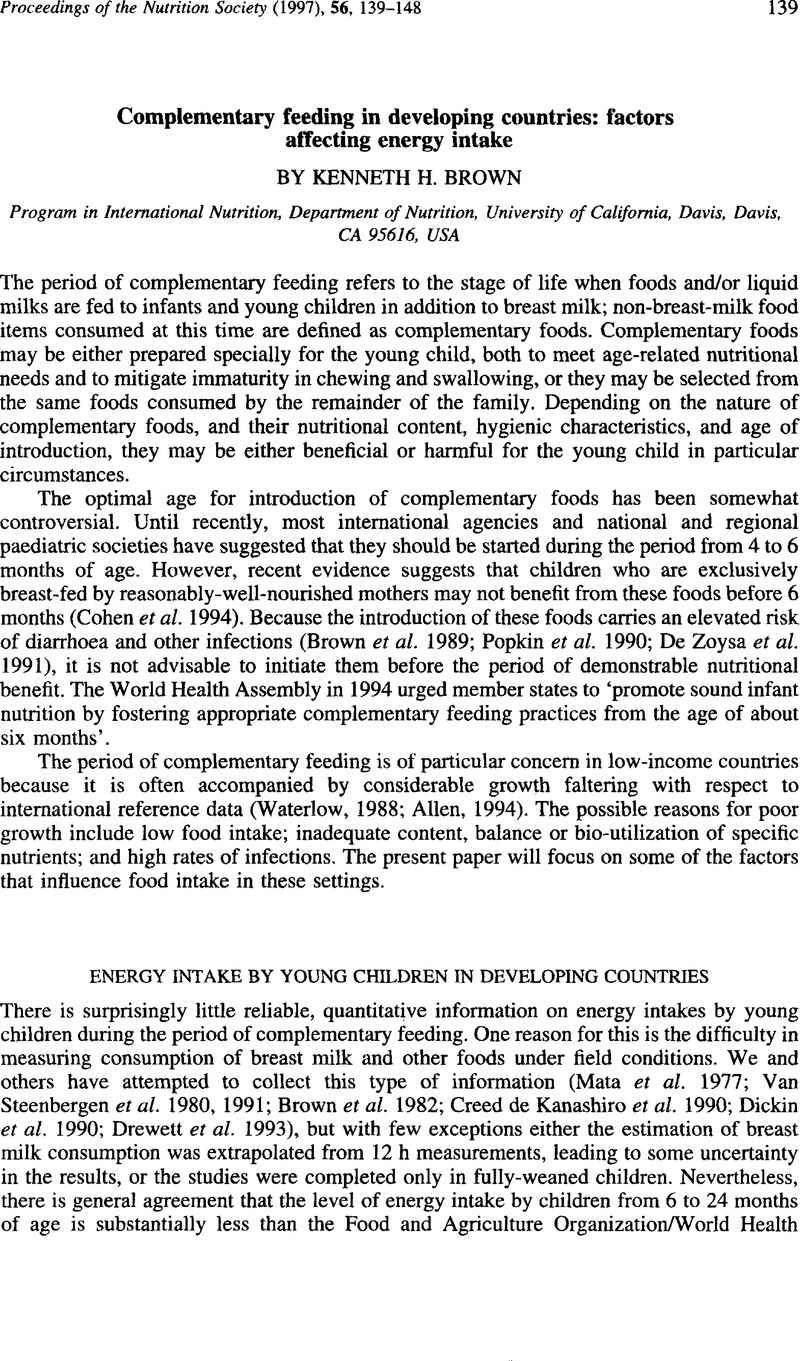Crossref Citations
This article has been cited by the following publications. This list is generated based on data provided by Crossref.
Bennett, Virginia A
Morales, Enrique
González, José
Peerson, Janet M
López de Romaña, Guillermo
and
Brown, Kenneth H
1999.
Effects of dietary viscosity and energy density on total daily energy consumption by young Peruvian children.
The American Journal of Clinical Nutrition,
Vol. 70,
Issue. 2,
p.
285.
McCrory, Megan A
Fuss, Paul J
McCallum, Joy E
Yao, Manjiang
Vinken, Angela G
Hays, Nicholas P
and
Roberts, Susan B
1999.
Dietary variety within food groups: association with energy intake and body fatness in men and women.
The American Journal of Clinical Nutrition,
Vol. 69,
Issue. 3,
p.
440.
Nichols, Buford L.
Nichols, Veda N.
Putman, Margaret
Avery, Stephen E.
Fraley, J. Kennard
Quaroni, Andrea
Shiner, Margot
Sterchi, Erwin E.
and
Carrazza, Francisco R.
2000.
Contribution of Villous Atrophy to Reduced Intestinal Maltase in Infants With Malnutrition.
Journal of Pediatric Gastroenterology and Nutrition,
Vol. 30,
Issue. 5,
p.
494.
Prentice, Andrew M
and
Paul, Alison A
2000.
Fat and energy needs of children in developing countries.
The American Journal of Clinical Nutrition,
Vol. 72,
Issue. 5,
p.
1253s.
Nichols, Buford L.
Nichols, Veda N.
Putman, Margaret
Avery, Stephen E.
Fraley, J. Kennard
Quaroni, Andrea
Shiner, Margot
Sterchi, Erwin E.
and
Carrazza, Francisco R.
2000.
Contribution of Villous Atrophy to Reduced Intestinal Maltase in Infants With Malnutrition.
Journal of Pediatric Gastroenterology and Nutrition,
Vol. 30,
Issue. 5,
p.
494.
Dossa, Romain A.M.
Ategbo, Eric-Alain D.
Van Raaij, Joop M.A.
de Graaf, Cees
and
Hautvast, Joseph G.A.J.
2001.
Multivitamin-Multimineral and Iron Supplementation Did Not Improve Appetite of Young Stunted and Anemic Beninese Children.
The Journal of Nutrition,
Vol. 131,
Issue. 11,
p.
2874.
Aggett, Peter J.
Agostoni, Carlo
Axelsson, Irene
Edwards, Christine A.
Goulet, Olivier
Hernell, Olle
Koletzko, Berthold
Lafeber, Harry N.
Micheli, Jean-Léopold
Michaelsen, Kim F.
Rigo, Jacques
Szajewska, Hania
and
Weaver, Lawrence T.
2003.
Nondigestible Carbohydrates in the Diets of Infants and Young Children: A Commentary by the ESPGHAN Committee on Nutrition.
Journal of Pediatric Gastroenterology and Nutrition,
Vol. 36,
Issue. 3,
p.
329.
Moursi, M
Mbemba, F
and
Trèche, S
2003.
Does the consumption of amylase-containing gruels impact on the energy intake and growth of Congolese infants?.
Public Health Nutrition,
Vol. 6,
Issue. 3,
p.
249.
Aggett, Peter J.
Agostoni, Carlo
Axelsson, Irene
Edwards, Christine A.
Goulet, Olivier
Hernell, Olle
Koletzko, Berthold
Lafeber, Harry N.
Micheli, Jean‐Léopold
Michaelsen, Kim F.
Rigo, Jacques
Szajewska, Hania
and
Weaver, Lawrence T.
2003.
Nondigestible Carbohydrates in the Diets of Infants and Young Children: A Commentary by the ESPGHAN Committee on Nutrition.
Journal of Pediatric Gastroenterology and Nutrition,
Vol. 36,
Issue. 3,
p.
329.
Traoré, Tahirou
Vieu, Marie-Catherine
Alfred, Traoré S.
and
Serge, Trèche
2005.
Effects of the duration of the habituation period on energy intakes from low and high energy density gruels by Burkinabè infants living in free conditions.
Appetite,
Vol. 45,
Issue. 3,
p.
279.
Gibson, Rosalind S.
Abebe, Yewelsew
Hambidge, K. Michael
Arbide, Isabel
Teshome, Aklilu
and
Stoecker, Barbara J.
2009.
Inadequate feeding practices and impaired growth among children from subsistence farming households in Sidama, Southern Ethiopia.
Maternal & Child Nutrition,
Vol. 5,
Issue. 3,
p.
260.
Van Hoan, Nguyen
Van Phu, Pham
Salvignol, Bertrand
Berger, Jacques
and
Trèche, Serge
2009.
Effect of the consumption of high energy dense and fortified gruels on energy and nutrient intakes of 6–10-month-old Vietnamese infants.
Appetite,
Vol. 53,
Issue. 2,
p.
233.
Lander, R
Enkhjargal, TS
Batjargal, J
Bolormaa, N
Enkhmyagmar, D
Tserendolgor, U
Tungalag, S
Bailey, K
and
Gibson, RS
2010.
Poor dietary quality of complementary foods is associated with multiple micronutrient deficiencies during early childhood in Mongolia.
Public Health Nutrition,
Vol. 13,
Issue. 9,
p.
1304.
Iuel‐Brockdorf, Ann‐Sophie
Ouedraogo, Albertine
Ritz, Christian
Draebel, Tania Aase
Ashorn, Per
Filteau, Suzanne
and
Michaelsen, Kim F.
2017.
Feeding behaviors during home‐based treatment of moderate acute malnutrition using corn‐soy blends or lipid‐based nutrient supplements.
Maternal & Child Nutrition,
Vol. 13,
Issue. 4,
Martin, Melanie A.
and
Glass, Delaney J.
2025.
Timing of Complementary Feeding and Infant Growth Trajectories in Prospective Cohort Studies: A Systematized Review and Analysis of Socioecological Variation.
Ecology of Food and Nutrition,
p.
1.



